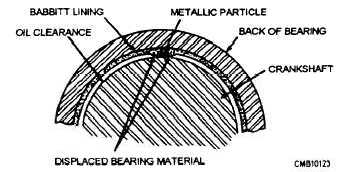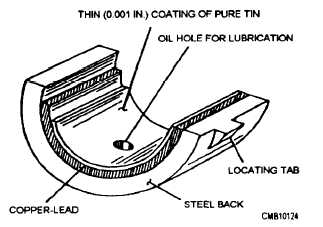carried down to the oil pan and released to the air passing around the oil pan. The oil also flushes and cleans the bearings. It tends to flush out particles of grit and dirt that may have worked into the bearing. The particles are carried back to the oil pan by the circulating oil. The particles then drop to the bottom of the oil pan or are removed from the oil by the oil screen or filter.
The greater the oil clearance, the faster the oil flows through the bearing; however, excessive oil clearance causes some bearings to fail from oil starvation. Here's the reason: If oil clearances are excessive, most of the oil passes through the nearest bearings. There is not enough oil for the most distant bearings; these bearings eventually fail from lack of oil. An engine with excessive bearing oil clearance usually has low oil pressure; the oil pump cannot build up normal pressure because of the excessive oil clearance in the bearings.
On the other hand, when the bearings have insufficient oil clearances, there is metal-to-metal contact between the bearings and the journal. Extremely rapid wear and quick failure is the end result. Also, there is not enough throw off for adequate lubrication of cylinder walls, pistons, and rings.
Bearing Characteristics
Engine bearings must operate under tremendous loads, severe temperature variations, abrasive action, and corrosive surroundings. Essential bearing characteristics include the following.
BEARING LOAD STRENGTH is the ability of a bearing to withstand pounding and crushing during engine operations. The piston and rod can produce several TONS of downward force. The bearing must not fatigue, flatten, or split under these loads. If the bearing load resistance is too low, the beating can smash, fail, and spin in its bore. This ruins the bore or the journal.
BEARING CONFORMABILITY is the ability of a bearing to move, shift, conform to variations in shaft alignment, and adjust to imperfections in the surface of the journal. Usually, a soft metal is placed over hard steel. This lets the bearing conform to the defects in the journal.
BEARING EMBEDABILITY refers to the ability of a bearing to permit foreign particles to become embedded in it (fig. 3-72). Dirt and metal are sometimes carried into the bearings. The bearing should allow the particles to sink beneath the surface into the bearing material. This prevents the particles from scratching, wearing, and damaging the surface of the crankshaft or camshaft journals.
BEARING CORROSION RESISTANCE is the ability of a bearing to resist corrosion from acid, water, and other impurities in the engine oil. Combustion blow-by gases cause engine oil contamination that can also corrode engine bearings. Aluminum-lead and other alloys are commonly being used because of their excellent corrosion resistance.
Bearing Materials
As discussed earlier, there are three basic types of engine bearings - connecting rod bearings, crankshaft main bearings, and camshaft bearings. The backing material (body of the bearing that contacts stationary parts) for engine bearings is normally steel. Softer alloys are bonded over the backing to form the bearing surface. Any one of three basic types of metal alloys can be plated over the top of the steel backing - Babbitt (lead-tin alloy), copper, or aluminum (fig. 3-73). These three metals may be used in different combinations to design bearings for either light-, medium-, or heavy- duty applications. The engine designer selects the combination of ingredients that will best suit the engine.

Figure 3-72. - Effect of a metallic particle embedded in bearing material (Babbitt lining).

Figure 3-73. - Bearing materials
Continue Reading